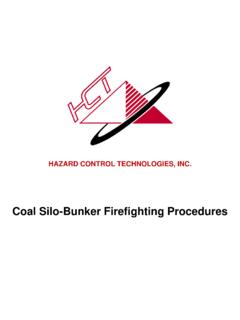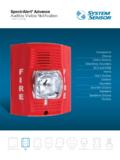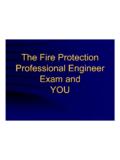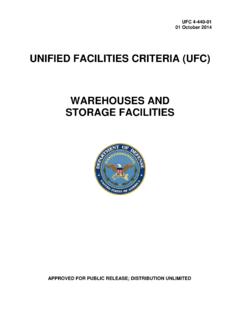Transcription of Consultant’s Guide for Designing Fire Detection & …
1 consultant 's Guide for Designing fire Detection & Alarm Systems part one Guide to design of fire systems contents About this manual Purpose 1. Readership 3. Electronic Format 4. Acknowledgments 4. Part One: Guide to Design of fire Systems 1. Introduction 7. Planning the System 10. The role of fire risk assessment and fire engineering 11. Variations from BS 5839-1 12. Type of system 12. Servicing arrangements 13. Planning flowchart 14. 2. Selecting the category of protection and coverage 17. Category M manual 18. Category L5 life 18. Category L4 life 19. Category L3 life 19. Category L2 life 20. Category L1 life 21. Category P2 property 21. Category P1 property 22. 3. Detector zones and alarm zones 23. The meaning of a Detection zone and alarm zone 23. The purpose of Detection zones 23.
2 Guide to design of fire systems part one part one Guide to design of fire systems contents Detection zone configuration guidelines 24. Detection zone safeguards 25. 4 Which type of fire Detection and alarm system? 29. Conventional systems 29. Detection zones 29. Detectors and call points 30. Addressable systems 30. Operation of addressable systems 31. Detectors and call points 31. Output devices 33. Digital addressable systems 34. Operation of analogue addressable detectors 34. Detector pre alarm warning 36. Detector alarm threshold compensation 37. Detector condition monitoring 38. Detector sensitivity setting 39. 5. Detector suitability 41. General fire system engineering principles 41. Detector selection for a particular area 43. Smoke detectors 43. Heat detectors 44. Heat-enhanced Carbon monoxide fire detectors 47.
3 Flame detectors 49. Optical beam detectors 52. Aspirating detectors 56. Duct probe unit 58. 6. Detector coverage 60. Spacing under flat ceilings 60. Spacing under pitched ceilings 62. Spacing in corridors 63. Stairways 63. Lift shafts and other flue-like structures 64. Obstructions 64. part one Guide to design of fire systems part one Guide to design of fire systems contents Honeycomb ceilings 66. Closely spaced structural beams and floor joists 67. Ceiling heights 69. Walls and partitions 70. Voids 72. Perforated ceilings 72. Ventilation 73. Lantern-lights 74. 7. Manual break glass call points 75. General information 75. Siting of manual call points 75. 8. Limitation of false alarms 78. Role of the designer 78. Categories of false alarm 81. Requirements for service technicians 81.
4 False alarm rates' 82. Causes of false alarms 85. Practical measures to limit false alarms 86. Siting and selection of manual call points 87. Selection and siting of automatic fire detectors 88. Selection of system type 90. Protection against electromagnetic interference 91. Performance monitoring of newly commissioned systems 92. Filtering measures 93. System management 97. Servicing and maintenance 98. 9. Means of giving warning to occupants 99. Sound pressure level 99. Discrimination and frequency 102. Sound continuity 102. Audible alarms in noisy areas 102. Alarm zones 103. External fire alarm devices 104. Guide to design of fire systems part one part one Guide to design of fire systems contents Voice alarm systems and voice sounders 104. fire alarm warnings for deaf people 105.
5 10. Control and indicating equipment 106. Siting of control and indicating equipment 106. Location of origin of the fire 107. Security of control equipment 107. Networked control panels 108. 11. Power supplies 109. Mains supply 109. Standby supply 110. Life protection (category M and L systems) 110. Property protection (category P systems) 111. Calculation of standby battery capacity 111. 12. Cabling considerations 114. Recommended cable types 114. Cable suitability 115. Conductor sizes 118. Segregation 118. Cable colour coding 119. Joints in cables 120. Cable support 120. Mechanical protection of cables 121. 13. Communication with the fire service 122. Automatic transmission of alarm signals 123. Category L systems 123. Category P systems 124. Methods of automatic transmission 124.
6 Standards for Alarm Receiving Centres (ARCs) 124. part one Guide to design of fire systems part one Guide to design of fire systems contents 14. System installation 125. Siting of equipment 126. Installation work 126. Inspection and testing 127. Commissioning and handover 128. 15. Documentation 132. 16. Maintenance 134. Routine testing 134. Servicing 135. 17. Responsibilities of user 137. Guide to design of fire systems part one part two specification for a digital addressable fire system contents Part Two: Specification for a Digital Addressable fire System 1. General Requirements 139. 2. Standards and Specifications 141. 3. Control and Indicating Equipment 144. General Requirements 144. System Configuration 145. Mechanical Design 147. Basic System Functions 147. Alarm Monitoring Functions 150.
7 Alarm Output Functions 151. Supervision and Fault Reporting 152. System Management Facilities 153. Technical Specification 155. 4. Automatic fire Detectors 156. General Requirements 156. Triple Sensing Detection 158. Optical Smoke Detectors 160. High Performance Optical Smoke Detectors 161. Infra-Red Flame Detectors 162. Infra Red Array Flame Detection 164. Heat Detectors 165. Linear Heat Detectors 166. Beam Smoke Detectors 167. Aspirating Smoke Detectors 169. Carbon Monoxide (CH) fire Detector 170. Remote Indicator Module 171. part two specification for a digital addressable fire system part two specification for a digital addressable fire system contents 5. Associated Ancillary Equipment 172. General Requirements 172. Addressable Manual Callpoints 172. Conventional Detector Interface Module (Including 4-20mAmonitoring) 173.
8 Addressable Relay Output Module 174. Addressable Contact Monitoring Module 174. Addressable Sounder Notification Module 175. Loop Powered Addressable Sounder Notification Module 175. Sounder Booster Module 175. Auxiliary Power Supplies 176. Line Isolator 176. Door Control Module 176. Multiple Input/ Output Module 177. Single Input/ Output Module 178. Loop Powered Beam Detector Module 178. Addressable Loop Powered Sounder/ Beacon 179. Addressable Loop Powered Sounder/ Beacon Base 179. 6. Cables 181. Type 181. Containment 181. 7. Networking and Graphics 183. Sub Panels 183. Graphical User Interface 183. 8. Documentation 187. Tender Documentation 187. Contract Documentation 187. specification for a digital addressable fire system part two part two specification for a digital addressable fire system contents 9.
9 Installation 189. General 189. Materials 189. Installation of Detectors 190. Installation of Control Devices 191. Installation of fire Controller Equipment 191. 10. Commissioning 193. General 193. Testing and Start-up 193. Commissioning 194. Handover 195. 11. Training 196. General 196. System Supervisor Training 196. Other Staff Training 196. 12. Maintenance 197. General 197. System Spares 197. System Test Equipment 198. Appendix A 199. Short Form Specification Key Points 199. Control & Indicating Equipment 199. Automatic Detectors 199. Associated Ancillary Equipment 200. Networking & Graphics 200. Training 200. part two specification for a digital addressable fire system page1. part one Guide to design of fire systems about this manual Purpose This manual is a consultants Guide to the contents and usage of the British The Code of Practice for fire Detection Standard Code for the design, installa- and alarm systems for buildings (BS tion and maintenance of fire Detection 5839- 1: 2002) is a detailed and com- and alarm systems for buildings (BS.)
10 Prehensive document which requires 5839-1: 2002). Throughout the ma- careful reading to fully understand its' nual, where it was necessary to refe- requirements and latest approach to rence this long title, we will simply refer ensuring the safety of buildings and to it as the Code'. their occupants from the ever present threat of fire . The Code is divided into seven sec- tions. The first section is intended to be The purpose of this manual is to pro- of general interest to all users, the se- vide a step by step approach to the cond is intended to be of interest to the necessary guidelines described in system designer, architect or electrical BS 5839-1:2002, so that users can engineer. The third section attempts achieve maximum benefit from the re- to address one of the major problems commendations.









